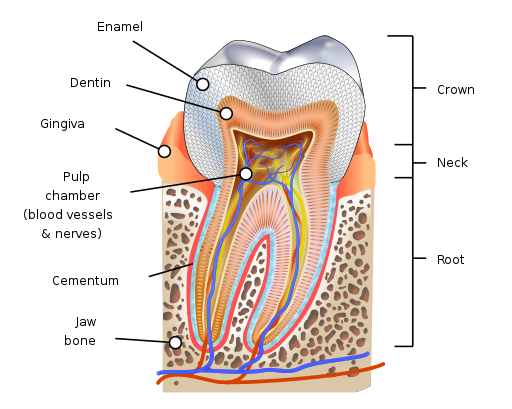Toothache
Peer reviewed by Dr Toni HazellLast updated by Dr Hayley Willacy, FRCGP Last updated 31 Oct 2022
Meets Patient’s editorial guidelines
- DownloadDownload
- Share
In this series:Tooth decayRoot canal treatmentsOral hygiene
Toothache is a painful sensation that comes from the teeth or the tissues that surround them. It is caused by inflammation of the dental pulp - the nerves and blood vessels inside our teeth. When the pulp becomes inflamed, this is called 'pulpitis'.
In this article:
Anybody who has experienced severe toothache knows that the pain can be excruciating. It is described by many people as the worst pain they have ever experienced. This explains why toothache remains the most common reason for emergency dental attendance and is a frequent reason for absence from work or school.
Continue reading below
Are toothaches common?
Toothache can affect adults and children of almost any age. To help your teeth remain healthy and pain-free it is important that you maintain an effective daily dental hygiene regime. Children's teeth should be cared for in a similar fashion as soon as they break through the gums.
Patient picks for Dental care

Oral and dental care
Is teeth whitening safe?
When it comes to our teeth, many of us feel insecure about our not-so-pearly whites. If you're looking for a brighter smile, you might be exploring teeth whitening options. But is there anything we should know about the safety of teeth whitening?
by Victoria Raw

Oral and dental care
Tooth decay
Tooth decay (dental caries) is the destruction of tooth tissue by the action of cariogenic bacteria. These are germs that cause dental caries.
by Dr Ben Williams, MB ChB
What causes toothache?
What causes toothache?
A tooth is made of three layers:
Enamel: the hard outer layer of teeth above the gum.
Dentine: the slightly softer layer under the enamel.
Pulp: nerves and blood vessels in the centre of a tooth.
Human tooth diagram

By KDS4444, CC BY-SA 4.0, via Wikimedia Commons
The dentine is made of a densely packed set of microscopic tubes leading from the enamel to the pulp. If the dentine loses its protective covering of enamel then harmful substances like germs, toxins and hot, cold or sweet stimuli are able to pass along the tubes of the dentine. They can then exert a damaging and painful effect on the living pulp underneath.
The pulp responds to these harmful stimuli by becoming inflamed (this is called pulpitis) as it tries to repair and defend itself.
There are two types of pulpitis:
Reversible pulpitis
In reversible pulpitis, the damage to the pulp is not extensive and has the potential to heal if the broken tooth receives appropriate dental treatment.
Irreversible pulpitis
In irreversible pulpitis, the inflammation and damage within the pulp is too extensive for the pulp to survive even with prompt dental treatment.
Tooth decay
Tooth decay (dental caries) is the most common cause of pulpitis. When we eat sugary food and drinks, the bacteria in our mouths consume the sugar and release acid. Over time the acid can dissolve a hole in the enamel layer of our teeth which allows the bacteria and their toxins to enter the softer layer of dentine and pass through it to irritate the pulp.
Side-effects of pulpitis
A side-effect of pulpitis is an increase in blood pressure around the nerves within the pulp. In cases of irreversible pulpitis the raised pressure inside the tooth limits the amount of blood that can enter the tooth. Without sufficient blood entering the tooth, the pulp will die painfully due to a lack of oxygen.
Continue reading below
What else causes pulpitis?
Apart from tooth decay, other possible causes of pulpitis include:
Loose, leaking, lost or broken fillings.
Gum wear, called 'recession'. This is caused by brushing too hard when brushing your teeth which exposes the sensitive dentine of the tooth root.
Having sensitive teeth. Avoid brushing too hard or consuming many acidic things in your diet. Both of these can thin the protective insulating layer of enamel.
Having a dental filling placed close to the pulp.
To understand the effect of temperature on the pulp, think about the sensation of biting into ice cream. When the dentine is exposed, sweet things and room temperature drinks can feel like ice cream sensitivity.
What else might the toothache be?
The following conditions may feel like toothache but do not actually involve the pulp:
Periodontal infections
These are infections which develop in the space between the tooth and gums. If you have gum disease, you are likely to have deeper spaces, called pockets, between the gums and teeth. Germs can multiply in these pockets and cause infections which may be painful and lead to bone loss.
Pericoronitis
This is an infection around a partially erupted tooth. Any tooth can be affected but most frequently it is the wisdom teeth. Your dentist will usually clean around the affected area to remove food and bacteria. You may need painkillers and antibiotics if the infection shows signs that it is spreading to other areas.
Trauma
Biting on an unexpected hard piece of food can cause the bone and ligaments around teeth to become bruised and painful to bite on to for several days. A soft diet and avoiding chewing on the tender teeth for a day or two usually resolve this problem.
Sinusitis
With sinusitis, the roots of upper teeth can be closely related to the air spaces - sinuses - in the upper jaw on either side of the nose. If there is a sinus infection or the sinuses become inflamed the increased pressure can push on the tooth nerves as they enter the root tip. This causes pain that feels like pulpitis. Over-the-counter decongestants may reduce the symptoms.
Continue reading below
What are the symptoms of toothache?
The symptoms of toothache are frequently confusing. It can be difficult to decide which tooth is causing the pain or even whether it's coming from an upper or a lower tooth. Sometimes the pain can feel like it is coming from a distant site, like your ear for example. This is called referred pain.
The most common symptoms of toothache are:
Pain
Understanding the type of pain can help the dentist to treat you more effectively.
Is it a sharp shooting pain or a dull ache?
Does the pain last for a few seconds or half an hour?
Does anything make the pain worse or make it go away?
The longer each episode of pain lasts, the more serious the condition is likely to be.
Hypersensitivity
Teeth with mild-to-moderate reversible pulpitis are usually more sensitive to cold or sweet food and drinks but rarely to hot ones.
Teeth with irreversible pulpitis are initially sensitive to cold but as the condition worsens the pulp becomes increasingly sensitive to hot things. Eventually, cold drinks can actually help to reduce the severe throbbing pain. This is because the cold temperature helps to reduce the pressure and inflammation inside the pulp, similar to an ice pack on a twisted knee or ankle.
Tenderness to pressure (TTP)
The more painful a tooth is to bite on, the more severe the pulpitis is likely to be. A tooth with reversible pulpitis might have no TTP at all. As the inflammation worsens to an irreversible pulpitis, the effects will spread beyond the root into the bone and make the tooth painful to bite on to. This makes teeth with irreversible pulpitis much easier to identify.
Pain on biting or pushing the side of a tooth can also indicate the presence of an infection spreading from the gums down the side of a tooth. It could also be due to inflammation or bruising around the tooth root if it has been knocked in an accident.
Inability to sleep
If your sleep is affected by toothache then it is likely you have irreversible pulpitis, especially if you are woken up in the middle of the night with a throbbing toothache that can last for hours.
If you experience any of these symptoms for more than a day or two without any reduction in severity, arrange to see your dentist as soon as possible. If you delay, the pain is likely to get worse.
How is toothache diagnosed?
Before starting any treatment your dentist will need to make sure that the source of your pain has been correctly identified. The first step is asking about the history of your toothache.
The questions might include:
How long have you had toothache?
How long does each episode of pain last?
Describe the pain? Where is it located? Is it a sharp pain or a dull throbbing pain? How painful is it on a scale of 1 to 10?
What causes the pain to start? Does anything make it go away? Does the pain start spontaneously by itself?
Is the tooth painful to bite or chew with? Is it sensitive to hot or cold food and drinks?
Does the pain affect your sleep?
Have you taken any painkillers and if so were they effective?
Are there any special tests for toothache?
Next, your dentist will examine your teeth and carry out some tests to gather more information.
Percussion testing
This is usually performed by tapping gently on teeth with a dental mirror handle and pushing on various teeth to identify which ones feel normal, a bit tender or very tender.
Vitality testing
This aims to identify if a pulp is healthy, inflamed or dead by placing hot or cold pieces of cotton wool against individual teeth. If a tooth feels the temperature difference, the pulp is alive or vital. An exaggerated response indicates the nerve may have pulpitis. A negative response implies the pulp may be dead. A pen-shaped device called an electric pulp tester can also be used to test if a pulp is alive.
X-rays
These can provide useful information about the presence and extent of tooth decay (dental caries), root fractures, the shape and depth of fillings, the presence of infections or abscesses around the roots of teeth and the proximity of teeth to the sinuses, nerves and other structures.
Testing for cracks
You will be asked to bite down repeatedly on to a plastic wedge-shaped instrument to identify cracks in a tooth that might be too small for the dentist to see directly. Sometimes shining a bright light against the tooth can help to visualise a crack.
Assessing the health of your gums
Your dentist will carefully assess the health of the gums around the painful teeth to check for inflammation, infections and signs of periodontal disease.
When all the relevant information has been gathered, your dentist will discuss the likely causes for your pain and provide you with a list of treatment options.
How to get rid of toothache
What is the treatment for toothache?
Most people will just want the pain to stop. Although your first thought may be to phone your GP surgery, this is not the best thing to do. GPs and their teams are not trained for dental problems and are actively advised by the General Medical Council not to try to manage them. In an emergency you can phone NHS 111 for advice.
Treatment for reversible pulpitis involves protecting the pulp from whatever was causing it to become inflamed. This usually involves the removal of tooth decay (dental caries) or any damaged fillings, followed by the placement of a new filling.
If a dentist has doubts about the pulp's chances of recovery then a temporary filling might be appropriate. The status of the pulp can be reassessed after some time to ensure that it has healed before a permanent filling is placed. If the pulp has not healed or the symptoms have increased then your tooth may need to undergo treatment for irreversible pulpitis (see below)
If the pulpitis was caused by a crack in a tooth it may be necessary to modify the site of the crack before replacing a filling or a crown, to prevent the tooth cracking in half.
After placement of a filling, it may take several days for the symptoms of reversible pulpitis to subside. Your dentist will advise you how to prevent further pulp irritation while it is healing. They may also prescribe pain-relieving medication which may also help to reduce inflammation within the pulp.
If the pulpitis was caused by a previous deep filling or tooth sensitivity due to gum recession, your dentist will advise you how to protect the tooth and avoid irritating the pulp to give it a chance to heal by itself. Special varnishes and protective coatings might help to reduce the symptoms, along with pain relief (painkillers) if your dentist recommends them. See the separate leaflet called Painkillers.
How is irreversible pulpitis treated?
Treatment for irreversible pulpitis consists of two main options. The same options apply for a tooth with a pulp that has died due to tooth decay (dental caries) or trauma.
Root canal treatment
Root canal treatment involves removal of the dying pulp, disinfecting and shaping the space inside the tooth and placing a specialised root filling material to prevent further infection of the pulp space. This procedure is often carried out over two appointments approximately two weeks apart.
Extraction of the painful tooth
This option might be necessary if there is not enough of the tooth remaining, after decay removal, to support a filling.
How can I prevent toothache?
The best way to avoid toothache is by attending routine dental appointments , brushing your teeth with fluoride toothpaste, maintaining a careful oral hygiene routine and reducing your intake of sugary foods and drinks that cause tooth decay (dental caries). For detailed oral hygiene and diet advice, speak to a member of your dental team.
Can toothache go away on its own?
If you delay seeing a dentist for too long then you will increase the likelihood of significant pulp damage. This is usually extremely painful and eating and drinking will become much more uncomfortable as the pulpitis spreads to affect the bone and ligament around the root tip. This can lead to severe, constant pain and sleepless nights. Without treatment, the pulp will eventually die and break down to form a dental abscess in the bone around the root of the tooth. When this happens, the dentist is left with only two options: root canal treatment or tooth extraction.
What else might it be?
Several other dental pain conditions have symptoms which may be confused with toothache but do not actually involve the pulp. These include sinusitis, mouth ulcers and gum infections, especially if you have partially erupted wisdom teeth or have gum disease.
Further reading and references
- Emmott R, Barber SK, Thompson W; Antibiotics and toothache: a social media review. Int J Pharm Pract. 2021 May 25;29(3):210-217. doi: 10.1093/ijpp/riaa024.
- Aranha RLB, Pinto RS, Abreu MHNG, et al; Factors associated with toothache among Brazilian adults: a multilevel analysis. Braz Oral Res. 2020 Apr 17;34:e036. doi: 10.1590/1807-3107bor-2020.vol34.0036. eCollection 2020.
Article history
The information on this page is written and peer reviewed by qualified clinicians.
Next review due: 30 Oct 2027
31 Oct 2022 | Latest version
25 Nov 2014 | Originally published
Authored by:
Toothpick

Are you protected against flu?
See if you are eligible for a free NHS flu jab today.

Feeling unwell?
Assess your symptoms online for free